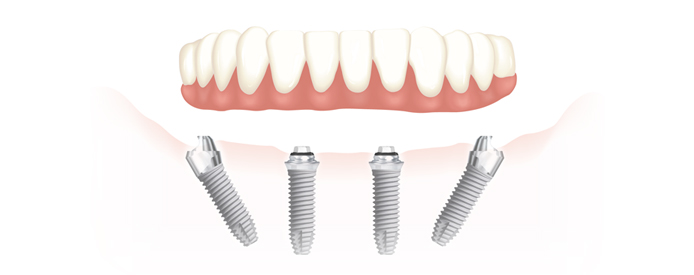What is the ‘All on Four’ treatment

All on 4 is a treatment concept. After the extraction of your adult teeth, it is a normal occurrence for the jaw bone that supported the lost teeth to itself be gradually lost. This may take years to occur. If implant supported restorations are then considered later in life, it may be that insufficient bone may remain across the entire jaw for well distributed dental implants. Surgical bone grafting procedures and nerve displacement procedures may make room for implants but these augmentation procedures, regardless of the type of procedure, carry a higher risk of surgical side effects and complications.
To avoid the need for grafting procedures and to maximise the effective use of the remaining bone, tilted implants have been suggested to help increase the number of teeth that can be replaced. This is a well-documented alternative to conventional implant protocols, with no apparent clinically significant difference in success rates compared with vertically placed implants.The principle of the ‘all-on-four’ concept is to use four implants in the anterior part of complete edentulous jaws to support a provisional, fixed, and immediately loaded restoration. The two most anterior implants are placed vertically, whereas the two posterior implants are tilted backwards to minimise the the length of the unsupported denture and to allow a bridge with up to 12 teeth.
It may be prudent, if bone permits, to over-engineer your restoration by the addition of further implants. In the event of the failure of one of your supporting implants, the restoration will be amply supported by the remaining dental implants. The term ‘ All on Four’ is a catchy marketing term used to draw the public’s attention to dental implant supported dentures and bridges. Fewer implants also means that the cost of the treatment can be reduced. The cost benefit needs to be balanced by the greater support provided by more implants. See your local prosthodontist to discuss your particular case and the options available to you.









